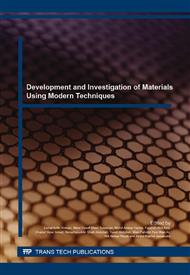p.267
p.271
p.276
p.281
p.289
p.294
p.299
p.305
p.309
Physical Properties of 316L Stainless Steel (SS316L) Foam with Different Composition by Using Compaction Method
Abstract:
Nowadays, the 316L stainless steel metal foams (SS316L) have acknowledged important attention in various fields and are required to be used as engineering materials including heat exchange, sound absorption, filtration and others. So, in this study the production of SS316L foams using different composition through compaction method by using a starch powder as space holder was studied. The range of selected composition of SS316L that obtained is between 50 wt% to 60 wt% while the remaining percentages are space holder and binder. The SS316L compact is prepared by mixing SS316L alloy powder, starch powder, and Polyethylene Glycol (PEG). Then, the mixture is compact into a mould under 8 tonnes of controlled pressure using hydraulic press machine. This is later sintered in a vacuum furnace. The sintered SS316L foams were characterised using a Scanning Electron Microscopy (SEM) analysis. Then, the physical properties of SS316L foam was also analysed by Archimedes method that includes porosity and bulk density test. As a result, the sample with 60 wt% were produced a good and finer pores and struts. Meanwhile, for that sample the percentage of porosity and bulk density are 0.19% and 7.44 g/cm3, respectively.
Info:
Periodical:
Pages:
289-293
Citation:
Online since:
January 2016
Authors:
Keywords:
Price:
Сopyright:
© 2016 Trans Tech Publications Ltd. All Rights Reserved
Share:
Citation:


